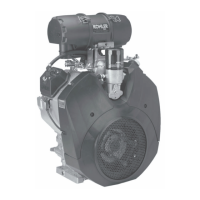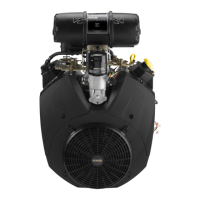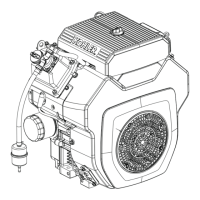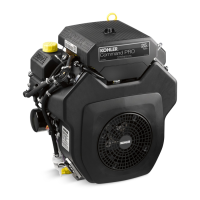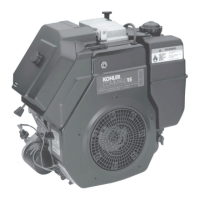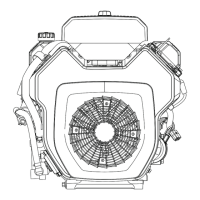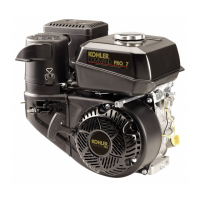Disassembly
5362 690 01 Rev. C KohlerEngines.com
Ring failure is usually indicated by excessive oil
consumption and blue exhaust smoke. When rings fail,
oil is allowed to enter combustion chamber where it is
burned along with fuel. High oil consumption can also
occur when piston ring end gap is incorrect because
ring cannot properly conform to cylinder wall under this
condition. Oil control is also lost when ring gaps are not
staggered during installation.
When cylinder temperatures get too high, lacquer and
varnish collect on pistons causing rings to stick, which
results in rapid wear. A worn ring usually takes on a
shiny or bright appearance.
Scratches on rings and pistons are caused by abrasive
material such as carbon, dirt, or pieces of hard metal.
Detonation damage occurs when a portion of fuel charge
ignites spontaneously from heat and pressure shortly
after ignition. This creates two fl ame fronts which meet
and explode to create extreme hammering pressures on
a specifi c area of piston. Detonation generally occurs
from using low octane fuels.
Preignition or ignition of fuel charge before timed spark
can cause damage similar to detonation. Preignition
damage is often more severe than detonation damage.
Preignition is caused by a hot spot in combustion
chamber from sources such as glowing carbon deposits,
blocked cooling fi ns, an improperly seated valve, or
wrong spark plug(s).
Replacement pistons are available in STD bore size, and
in 0.25 mm (0.010 in.), and 0.50 mm (0.020 in.) oversize.
Replacement pistons include new piston ring sets and
new piston pins.
Replacement ring sets are also available separately
for STD, 0.25 mm (0.010 in.), and 0.50 mm (0.020 in.)
oversize pistons. Always use new piston rings when
installing pistons. Never reuse old rings.
Some important points to remember when servicing
piston rings:
1. Cylinder bore must be deglazed before service ring
sets are used.
2. If cylinder bore does not need reboring and if old
piston is within wear limits and free of score or scuff
marks, old piston may be reused.
3. Remove old rings and clean up grooves. Never
reuse old rings.
4. Before installing new rings on piston, place top two
rings, each in turn, in its running area in cylinder
bore and check end gap. Compare ring gap to
specifi cations.
5. After installing new compression (top and middle)
rings on piston, match piston-to-ring side clearance
to specifi cations. If side clearance is greater than
specifi ed, a new piston must be used.
Install New Piston Rings
To install new piston rings, proceed as follows:
NOTE: Rings must be installed correctly. Ring
installation instructions are usually included with
new ring sets. Follow instructions carefully. Use
a piston ring expander to install rings. Install
bottom (oil control) ring fi rst and top
compression ring last.
1. Oil control ring (bottom groove): Install expander and
then rails. Make sure ends of expander are not
overlapped.
2. Middle compression ring (center groove): Install
center ring using a piston ring installation tool. Make
sure identifi cation mark is up or dykem stripe
(if contained), is to left of end gap.
3. Top compression ring (top groove): Install top ring
using a piston ring expander. Make sure
identifi cation mark is up or dykem stripe
(if contained), is to left of end gap.
Remove Crankshaft
NOTE: If crankpin is reground, visually check to ensure
that fi llet blends smoothly with crankpin surface.
Carefully pull crankshaft from crankcase. Note thrust
washers and shims if used.
Inspection and Service
A Self-Tapping Screw B Flat Washer
C Plug D Crankshaft
Fillet Must Blend
Smoothly with
Bearing Journal
Surface
45°
High Point from Fillet
Intersections
This Fillet Area
Must Be
Completely Smooth
Minimum
Inspect gear teeth of crankshaft. If teeth are badly worn,
chipped, or some are missing, replacement of crankshaft
will be necessary.
Inspect crankshaft bearing surfaces for scoring,
grooving, etc. Replaceable bearings are used in
crankshaft bore of closure plate and/or crankcase.
Do not replace bearings unless they show signs of
damage or are out of running clearance specifi cations.
If crankshaft turns easily, without noise, and there is no
evidence of scoring, grooving, etc., on races or bearing
surfaces, bearings can be reused.
A
B
C
D
